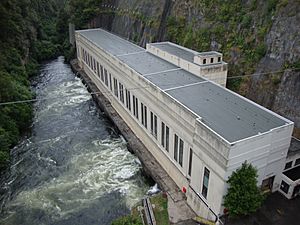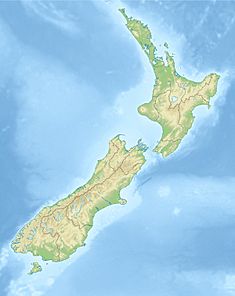Arapuni Power Station facts for kids
Quick facts for kids Arapuni Dam |
|
|---|---|

Arapuni power station, as seen from the Arapuni Suspension Bridge
|
|
|
Location of Arapuni Dam in New Zealand
|
|
| Country | New Zealand |
| Location | Lake Arapuni, Waikato River |
| Coordinates | 38°4′17″S 175°38′36″E / 38.07139°S 175.64333°E |
| Purpose | Power |
| Status | Operational |
| Opening date | 1929 |
| Dam and spillways | |
| Impounds | Waikato River |
| Reservoir | |
| Creates | Lake Arapuni |
| Power station | |
| Name | Arapuni Power Station |
| Operator(s) | Mercury Energy |
| Turbines | 8× Francis turbines |
| Installed capacity | 196.66 MW (263,730 hp) |
| Annual generation | 805 GWh (2,900 TJ) |
The Arapuni Power Station is a big power plant in New Zealand that makes electricity using the power of water. It's located on the Waikato River in the North Island. This power station is owned and run by a company called Mercury Energy. It's special because it's the oldest power station on the Waikato River that is still making electricity today. It was also the first one built by the government!
Arapuni is very important for keeping the electricity steady and reliable in Hamilton and the wider Waikato area. Even though it's over 80 years old, it's always being improved. This helps Arapuni stay efficient and keep making power.
Contents
A Look Back: How Arapuni Was Built
Arapuni was the first power station built by the New Zealand government on the Waikato River. Before it, there was a private power station called Horahora Power Station. Horahora stopped working in 1947 when Lake Karapiro was filled.
Early Challenges and First Steps
Engineers started looking at the Arapuni site in 1916. But in 1920, the plans stopped because the government didn't have enough money. Building Arapuni finally began in 1924. However, heavy rain and floods made the early work very difficult.
The power station officially opened in mid-1929. It had three big machines called turbines, with space for a fourth. Soon after opening, Arapuni had to close for two years. Workers needed to fix a problem with water leaking and line the water channel. The station reopened in May 1932, with the fourth turbine added.
The Arapuni Suspension Bridge was opened in 1926. It's just downstream from the power station. This bridge helped workers get from their camp (which became the Arapuni town) on one side of the river to the construction site on the other side.
Connecting the North Island
At first, the electricity from Arapuni was sent at 110,000 volts. It travelled along power lines to Penrose substation in Auckland. There were also smaller stations in Hamilton and Bombay.
In 1934, a new 110,000-volt line was built from Arapuni to Stratford. This connected Arapuni to other power stations like Mangahao in the lower North Island.
Growing with Demand
People needed more and more electricity in 1934. So, Arapuni was made bigger. The building that held the turbines was doubled in size. There was now space for four more turbines. Turbines 5 and 6 started working in 1938. The last two turbines were added in 1946. This helped meet the huge demand for electricity after World War II.
Keeping It Modern
In 1990, a big project costing $50 million was finished. This project repaired, updated, and improved the power station. One part of this work was building a new water channel.
Around 2000, the old water leaking problem got worse. Workers did some quick fixes while they planned a bigger solution. From 2005 to 2007, a $20 million project fixed the problem for good. Also, in 2001, four of Arapuni's turbines were upgraded. This made each one produce more power and work better.
Why is Arapuni Important?
Arapuni Power Station is very important for New Zealand's electricity supply. It's the largest single hydroelectric power station on the Waikato River. This means it can produce a lot of power from water. It helps keep the lights on and homes warm for many people in the North Island.
Protecting History
The buildings and dam at Arapuni are very special. They are protected by Historic Places Trust. This means they are important historical sites. The powerhouse was listed in November 1987, and the dam in August 1991. Arapuni is one of the few power stations in New Zealand that is also a protected historic place.



